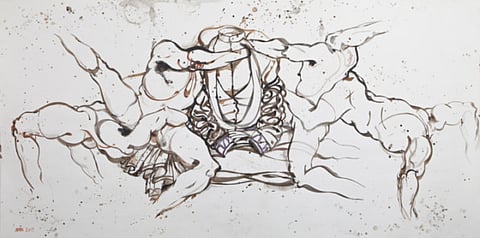The battle within
Ahmad Ameen Nazar exhorts viewers to take a deeper look at the battles we are enmeshed in — within ourselves and with the world outside

Well-known Iranian artist Ahmad Ameen Nazar’s paintings are usually inspired by heroes and demons from Persian mythology or the dramatic stories of kings and warriors of the Qajar dynasty. But his latest body of work, titled “Salto”, is quite different. It is a series of large drawings on paper depicting wrestlers grappling with each other. The artist has used ink and diluted acrylic paints to impart a sepia tone to the drawings, which have the look and feel of renaissance-style figurative studies. The muscular bodies are faceless, and the figures have been created from a few fluid strokes and lines. But you can feel the aggression and tension that exists between the intertwined figures. “Salto”, which is Latin for “leap” or “somersault”, refer to the figures appearing to be suspended or in free fall.
“This series was originally inspired by pictures of wrestlers in the sports pages of newspapers and magazines. Later I did research on Sumo wrestling, studied figurative drawing from different eras and eventually used my own imagination to create the various positions in which the bodies are interlocked. I have distilled the forms from my previous work into just a few lines and strokes to delineate the bodies, without indicating whether they belong to a hero or villain,” the artist says.
The intertwining of the figures suggesting their symbiotic relationship and the ambiguity about whether the figures represent good or evil and whether good has conquered evil or vice versa comprise the central theme of the work. Even though most of the figures are muscular, the ambiguity also extends to the gender of the figures. The ambiguity is heightened as the dynamics between the figures change when the drawings are viewed from different perspectives. Figures that seemed to be fighting look like they are hugging; what looked like assault appears to be protection; and two figures of men engaged in combat seem like a man and woman in love when seen from another viewpoint.
Nazar has achieved this effect through an interesting technique: he placed the paper on the ground and painted the figures from all sides. In fact, he has put tiny arrows pointing in different directions on the edge of the drawings to indicate the various orientations in which they can be hung and viewed. The artist, who is considered a master of figurative art, has created these complex drawings with quick, spontaneous strokes and has left paint drippings, his own footprints and the marks made by his paint bucket on the paper to add to the sense of spontaneity and energy in these works.
In some of the drawings you can see figures dressed like royalty and the wrestlers attempting to topple them, suggesting that these drawings might be about the conflict and power struggles going on in the region. But Nazar’s work is not just about external conflict. His drawings are essentially about the struggles going on within each human being and the leap we take into the unknown, which is our inner selves and life itself.
“In my earlier work you can clearly see who are the heroes and the villains. But here, you turn the drawing around and good changes to evil. The intertwined bodies refer to the fact that we all have good and evil within us and different circumstances bring out different sides of us. They reflect the chaos, violence, confusion, power struggles, good and bad, aggression and seduction, and all the ambiguity that exists within us and all around us in the world. ‘Salto mortale’ (deadly leap) is a philosophical term that has come into wrestling, where it refers to an attacking jump that is risky because it could be lethal for the attacker himself. The suspended figures in these drawings have taken that risky leap into the unknown and are strong as well as vulnerable as they struggle with the conflicts inside them and those in the outside world,” Nazar says.
Jyoti Kalsi is an arts enthusiast based in Dubai.
“Salto” will run at Gallery Isabelle Van den Eynde until January 10, 2013.
Box:
The Seat of Perception
All the paintings in Lebanese artist Walid Al Masri’s exhibition titled “The Seat of Perception” are focused on a single subject — chairs. They range from wooden rocking chairs to luxurious thrones; and from stylish chairs with colourful upholstery to pieces that are crumbling. But for the artist these chairs are merely a means for exploring the fundamental components of painting and perception, and experimenting with his palette and compositions.
Al Masri’s paintings are almost like abstract studies. With a vanishing point that lies beyond the edge of the canvas, the chairs appear to be floating at various angles and are often truncated by the top edge of the canvas. While they occupy the upper part of the canvas, the lower portion is always left vacant. “Observing nature made me realise that everything changes with each passing moment, so that repetition is never the same. My present fixation with chairs may seem repetitive, but each one of these chairs is unique and I revel in emphasising their intangible differences. A chair is a simple object that can be easily recognised even if you depict it just with a few vertical and horizontal lines. And I needed that simplicity to be able to explore the more elusive meaning of existence. When I am painting I forget everything else and get lost in my own world. The emptiness in the lower half of my canvases represents a space where one can forget everything and is an attempt to draw my viewers into my world,” he says.
“The Seat of Perception” will run at Ayyam Gallery, DIFC, until December 31.
Sign up for the Daily Briefing
Get the latest news and updates straight to your inbox



